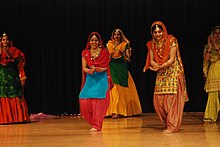Giddha
 | |
| Genre | Folk dance |
|---|---|
Giddha (Punjabi: گدها, giddhā) is a popular folk dance of women in Punjab region of India and Pakistan. The dance is often considered derived from the ancient dance known as the ring dance and is just as energetic as bhangra; at the same time it manages to creatively display feminine grace, elegance and flexibility. It is a very colourful dance form which is now copied in all regions of the country. Women perform this dance mainly at festive or social occasions.[1] The dance is followed by rhythmic clapping and a typical traditional folk song is sung by the aged ladies in the background. There is a spontaneous display of joy whenever the performance takes place.
History
Giddha is said to be originated from the ancient ring dance which was dominant in Punjab in the olden days. Women show the same level of energy which the men show while performing bhangra. The fragrance of feminine grace can be easily understood if one watches the dance with interest.[2]
Dress code

Traditionally women used to wear salwar kameez in the same colours and jewellery. The attire is completed by wearing a tikka on the forehead.[3]
References
- ^ Bhargava, Gopal. Land and people of Indian states and union territories. p. 215.
- ^ "Giddha Origin and history". utsavpedia.com. Retrieved 9 March 2017.
- ^ "Giddha Dress Code". indianmirror.com. Retrieved 9 March 2017.
